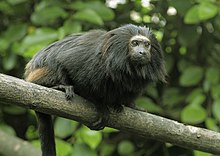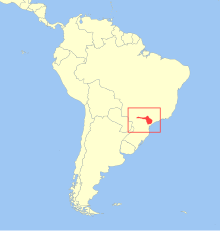| Black lion tamarin[1][2] | |
|---|---|

| |
| Black lion tamarin at Bristol Zoo | |
| Scientific classification | |
| Domain: | Eukaryota |
| Kingdom: | Animalia |
| Phylum: | Chordata |
| Class: | Mammalia |
| Order: | Primates |
| Suborder: | Haplorhini |
| Infraorder: | Simiiformes |
| Family: | Callitrichidae |
| Genus: | Leontopithecus |
| Species: | L. chrysopygus
|
| Binomial name | |
| Leontopithecus chrysopygus (Mikan, 1823)
| |

| |
| Synonyms | |
|
ater Lesson, 1840 | |
The black lion tamarin (Leontopithecus chrysopygus), also known as the golden-rumped lion tamarin, is a lion tamarin endemic to the Brazilian state of São Paulo, almost exclusively at the Morro do Diabo State Park. Its limited geographical range makes it the rarest of the New World monkeys, with little known about it.[5] It was thought to be extinct for 65 years until its rediscovery in 1970.[6] In 2016 an adult couple was found to the east, in the Caetetus Ecological Station, after six years with no sightings.[7]
A 2020 assessment by the International Union for Conservation of Nature (IUCN) estimated that there were 1,600 individuals living in the wild, 1,200 of which are found in Morro do Diabo State Park.[3] They are usually found in groups of 4 to 9, living in the secondary and primary forests along the circumference of its home range.
On average, the black lion tamarin weighs 300–700 grams (11–25 oz).[8]
- ^ Groves, C. P. (2005). Wilson, D. E.; Reeder, D. M. (eds.). Mammal Species of the World: A Taxonomic and Geographic Reference (3rd ed.). Baltimore: Johns Hopkins University Press. p. 133. ISBN 0-801-88221-4. OCLC 62265494.
- ^ Rylands, A.B.; Mittermeier, R.A. (2009). "The Diversity of the New World Primates (Platyrrhini)". In Garber, P.A.; Estrada, A.; Bicca-Marques, J.C.; Heymann, E.W.; Strier, K.B. (eds.). South American Primates: Comparative Perspectives in the Study of Behavior, Ecology, and Conservation. Springer. pp. 23–54. ISBN 978-0-387-78704-6.
- ^ a b Rezende, G.C.; Knogge, C.; Passos, F.C.; Ludwig, G.; Oliveira, L.C.; Jerusalinsky, L.; Mittermeier, R.A. (2020). "Leontopithecus chrysopygus". IUCN Red List of Threatened Species. 2020: e.T11505A17935400. doi:10.2305/IUCN.UK.2020-2.RLTS.T11505A17935400.en. Retrieved 19 November 2021.
- ^ "Appendices | CITES". cites.org. Retrieved 2022-01-14.
- ^ Snowdon, Charles T.; Hodun, Alexandra; Rosenberger, Alfred L.; Coimbra-Filho, Adelmar F. (1 January 1986). "Long-call structure and its relation to taxonomy in lion tamarins". American Journal of Primatology. 11 (3): 253–261. doi:10.1002/ajp.1350110307. PMID 31979452. S2CID 83673079.
- ^ Albernaz, Ana L. K. M. (1 January 1997). "Home Range Size and Habitat Use in the Black Lion Tamarin (Leontopithecus chrysopygus)". International Journal of Primatology. 18 (6): 877–887. doi:10.1023/A:1026387912013. S2CID 41247033.
- ^ Mico-leão-preto ressurge na Estação Ecológica Caetetus (in Portuguese), Fundação Florestal, 8 September 2016, retrieved 2017-02-21
- ^ Gray, D. (2003). "Black lion tamarin (Leontopithecus chrysophygus)". Animal Diversity Web (ADW). Animal Diversity Web. Retrieved 2021-03-30.
